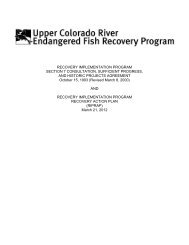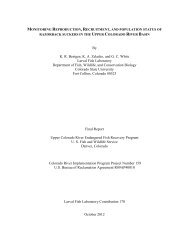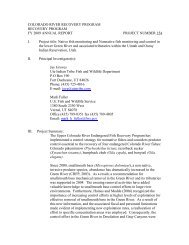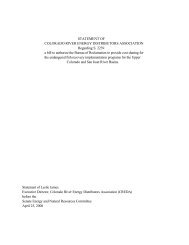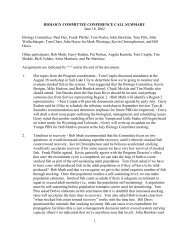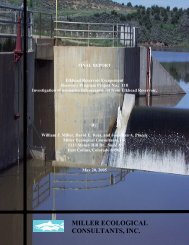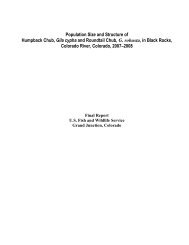Final Programmatic Biological Opinion for Bureau of Reclamation's
Final Programmatic Biological Opinion for Bureau of Reclamation's
Final Programmatic Biological Opinion for Bureau of Reclamation's
You also want an ePaper? Increase the reach of your titles
YUMPU automatically turns print PDFs into web optimized ePapers that Google loves.
Utah, Grand County; and Colorado, Mesa County. The Colorado River from BlackRocks (river mile 137) in T. 10 S., R. 104 W., section 25 (6th Principal Meridian) to FishFord in T. 21 S., R. 24 E., section 35 (Salt Lake Meridian).Utah, Garfield and San Juan Counties. The Colorado River from Brown Betty Rapid in T.30 S., R. 18 E., section 34 (Salt Lake Meridian) to Imperial Canyon in T. 31 S., R. 17 E.,section 28 (Salt Lake Meridian).Status and DistributionThe bonytail is the rarest native fish in the Colorado River. It was listed as endangered onApril 23, 1980. Formerly reported as widespread and abundant in mainstem rivers (Jordan andEvermann 1896), its populations have been greatly reduced. The fish is presently represented inthe wild by a low number <strong>of</strong> old adult fish in Lake Mohave and perhaps other lower basinreservoirs (USFWS 1990a). The last known riverine area where bonytail were common was theGreen River in Dinosaur National Monument, where Vanicek (1967) and Holden and Stalnaker(1970) collected 91 specimens during 1962-1966. From 1977 to 1983, no bonytail were collectedfrom the Colorado or Gunnison Rivers in Colorado or Utah (Wick et al. 1979, 1981; Valdez et al.1982; Miller et al. 1984). However, in 1984, a single bonytail was collected from Black Rocks onthe Colorado River (Kaeding et al. 1986). Several suspected bonytail were captured in CataractCanyon in 1985-1987 (Valdez 1990).The existing habitat has been modified to the extent that it impairs essential behavior patterns,such as breeding, feeding, and sheltering.Life HistoryThe bonytail is considered a species that is adapted to mainstem rivers, where it has beenobserved in pools and eddies (Vanicek 1967; Minckley 1973). Spawning <strong>of</strong> bonytail has neverbeen observed in a river, but ripe fish were collected in Dinosaur National Monument during lateJune and early July suggesting that spawning occurred at water temperatures <strong>of</strong> about 18° C(Vanicek and Kramer 1969).Population DynamicsThe number <strong>of</strong> bonytail in the upper Colorado River are so low that it is not possible to do apopulation estimate.Analysis <strong>of</strong> Species/Critical Habitat Likely to be AffectedBlack Rocks and Cataract Canyon are the only areas where bonytail have been found in the UpperColorado River in the last 20 years. So few fish have been captured that it is difficult todetermine species and habitat needs.35



